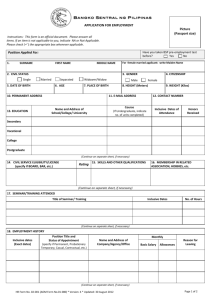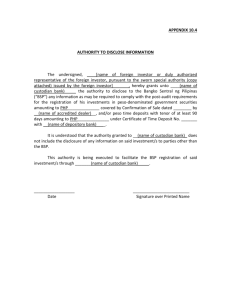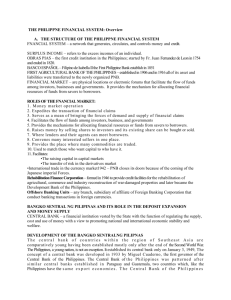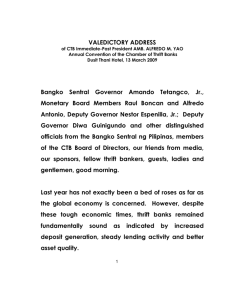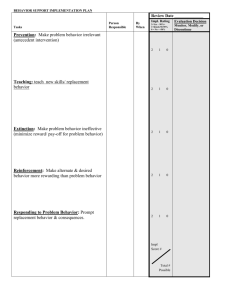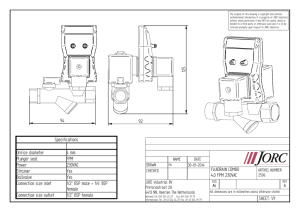Consumer Education Campaign - Bangko Sentral ng Pilipinas
advertisement
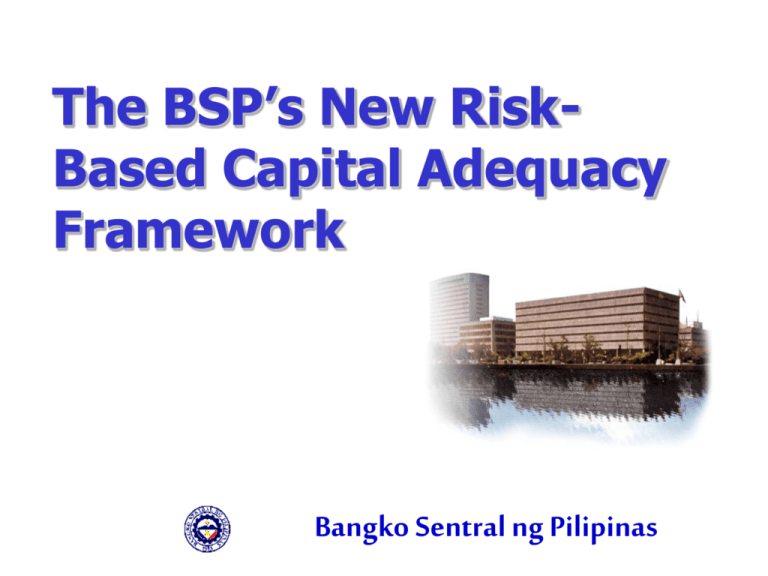
The BSP’s New RiskBased Capital Adequacy
Framework
Bangko Sentral ng Pilipinas
2
International Convergence of Capital
Measurement and Capital Standards:
A Revised Framework
“Basel 2”
Bangko Sentral
Briefing on the BSP’s New Risk-Based
Capital Adequacy Framework
26 August 2005
International Convergence of Capital Measurement and
Capital Standards: A Revised Framework
“Basel 2”
• Document issued by the Basel Committee on
Banking Supervision (BCBS) on 25 June 2004
• Revision of the 1988 Capital Accord and its
amendments (“Basel 1”)
– Minimum capital requirements based on credit risk
and market risk
• Promotes adoption of stronger risk
management practices by banks
• Framework based on three mutually
reinforcing “pillars”
Bangko Sentral
Briefing on the BSP’s New Risk-Based
Capital Adequacy Framework
26 August 2005
3
International Convergence of Capital Measurement and
Capital Standards: A Revised Framework
“Basel 2”
THE THREE PILLARS
Minimum Capital
Requirements (Pillar 1)
Supervisory Review
Process (Pillar 2)
Bangko Sentral
Market Discipline
(Pillar 3)
Briefing on the BSP’s New Risk-Based
Capital Adequacy Framework
26 August 2005
4
International Convergence of Capital Measurement and
Capital Standards: A Revised Framework
“Basel 2”
• Pillar 1: Minimum Capital Requirements
“Banks should have capital appropriate for their
risk-taking activities.”
• Prescribes requirements for
– Credit Risk (major change)
– Market Risk (minor change)
– Operational Risk (new provision)
that can be computed using different approaches
depending on banks’ level of sophistication
Bangko Sentral
Briefing on the BSP’s New Risk-Based
Capital Adequacy Framework
26 August 2005
5
International Convergence of Capital Measurement and
Capital Standards: A Revised Framework
“Basel 2”
Menu of Approaches to Capital Charge Computation
SIMPLE
COMPLEX
Credit Risk
Standardized Approach
Market Risk
Standardized Approach
Operational
Risk
Basic
Indicator
Approach
Standardized
Approach
Bangko Sentral
Internal Ratings-Based
Approaches
Foundation
IRB
Advanced
IRB
Internal VaR Models
Advanced Measurement
Approaches
Briefing on the BSP’s New Risk-Based
Capital Adequacy Framework
26 August 2005
6
International Convergence of Capital Measurement and
Capital Standards: A Revised Framework
“Basel 2”
• Pillar 2: Supervisory Review Process
“Banks should be able to properly assess their
capital adequacy in relation to the risk they are
taking, and supervisors should be able to
evaluate the soundness of these assessments.”
• Pillar 3: Market Discipline
“Banks should be disclosing pertinent information
necessary to enable market mechanism to
complement the supervisory oversight function.”
Bangko Sentral
Briefing on the BSP’s New Risk-Based
Capital Adequacy Framework
26 August 2005
7
8
Basel 2
BSP’s Implementation
Plans
Bangko Sentral
Briefing on the BSP’s New Risk-Based
Capital Adequacy Framework
26 August 2005
BSP’s Implementation Plans
Where We Are Now
• Adopted Basel 1 through the issuance of:
– Circular No. 280 (capital requirements
for credit risk; 03/2001),
– Circular No. 360 (capital requirements
for market risk; 12/2002)
– Circular No. 400 (capital requirements
for credit risk for quasi-banks; 8/2003)
– + AMENDMENTS
Bangko Sentral
Briefing on the BSP’s New Risk-Based
Capital Adequacy Framework
26 August 2005
9
BSP’s Implementation Plans
Where We Are Headed
• Issued Memorandum to All Banks dated 13
December 2004 (per MB Res. No. 1516 dated
14 October 2004)
• To be implemented in the Philippines by 2007
– For UBs/KBs: standardized approach for
credit risk and basic indicator or
standardized approach for operational risk,
plus existing market risk framework
Bangko Sentral
Briefing on the BSP’s New Risk-Based
Capital Adequacy Framework
26 August 2005
10
BSP’s Implementation Plans
Where We Are Headed
• To be implemented in the Philippines by 2007
(cont.)
– For TBs that are S&A of UBs/KBs approach of parent
– For stand-alone TBs, RBs and Coop Banks
- enhanced Basel 1 approach
• Implementation guidelines are in the
EXPOSURE DRAFT
Bangko Sentral
Briefing on the BSP’s New Risk-Based
Capital Adequacy Framework
26 August 2005
11
12
The BSP’s New Risk-Based Capital Adequacy Framework
A Snapshot
2005
2006
Gradual phasing in
of certain Basel 2
provisions
(securitization SA,
past dues, highest
credit quality
corporates)
2007
2008
2009
2010
Credit Risk
- standardized
approach
Credit Risk
- FIRB and AIRB
allowed
Operational Risk
- basic indicator
or standardized
approach
Operational Risk
- AMA allowed
Pillar 2 (Supervisory Review) - a continuing process
Pillar 3 (Market Discipline) -
Bangko Sentral
gradual implementation
starting 2007
Briefing on the BSP’s New Risk-Based
Capital Adequacy Framework
26 August 2005
13
Exposure Draft
The BSP’s New Risk-Based
Capital Adequacy
Framework
Bangko Sentral
Briefing on the BSP’s New Risk-Based
Capital Adequacy Framework
26 August 2005
14
The BSP’s New Risk-Based Capital Adequacy Framework
Scope of Application
• To be applied on both solo and consolidated
bases to banks and their financial/nonfinancial allied/non-allied subsidiaries/
associates at each bank level in a banking
group
– For purposes of line-by-line consolidation,
only financial allied subsidiaries,
excluding insurance companies and
securities brokers/dealers, are included.
– Subsidiaries refer to ownership of >50% in
an enterprise
Bangko Sentral
Briefing on the BSP’s New Risk-Based
Capital Adequacy Framework
26 August 2005
15
The BSP’s New Risk-Based Capital Adequacy Framework
Scope of Application
Diversified
Financial Group
Holding
Company
Universal Bank
Commercial
Bank
IH QB
Securities
B/D
Insurance
Company
Thrift
Bank
Bangko Sentral
Briefing on the BSP’s New Risk-Based
Capital Adequacy Framework
26 August 2005
16
The BSP’s New Risk-Based Capital Adequacy Framework
Scope of Application
• Treatment of subsidiary insurance
companies and securities
brokers/dealers
– to be deducted from capital on both
solo and consolidated bases
– capital shortfalls of these subsidiaries
with other regulatory agencies
likewise to be deducted from capital
Bangko Sentral
Briefing on the BSP’s New Risk-Based
Capital Adequacy Framework
26 August 2005
17
The BSP’s New Risk-Based Capital Adequacy Framework
Scope of Application
• Treatment of subsidiary insurance companies
ABC Bank
Asset
Loans
Investment in XYZ Insurance
Subsidiary
Total
8,750
250
9,000
Liabilities and Capital
Liabilities
8,100
Capital
900
Total
9,000
XYZ Insurance Subsidiary
Asset
Loans
4,000
Liabilities and Capital
Liabilities
3,750
Capital
250
Total
4,000
Total
Bangko Sentral
4,000
Briefing on the BSP’s New Risk-Based
Capital Adequacy Framework
26 August 2005
18
The BSP’s New Risk-Based Capital Adequacy Framework
Scope of Application
• Treatment of non-financial allied
subsidiaries, as well as significant
minority investments in
financial/non-financial allied/nonallied undertakings (>20%-50%
ownership)
– to be deducted from capital on both solo
and consolidated bases
Bangko Sentral
Briefing on the BSP’s New Risk-Based
Capital Adequacy Framework
26 August 2005
19
The BSP’s New Risk-Based Capital Adequacy Framework
Capital Requirements
• Includes capital charges for
– credit risk according to the
standardized approach
– market risk according to either the
standardized or internal models
approach
– operational risk according to the basic
indicator or standardized approach
Bangko Sentral
Briefing on the BSP’s New Risk-Based
Capital Adequacy Framework
26 August 2005
20
Credit Risk Measurement
Risk Weights
• Banking book exposures are risk-weighted based on
external assessments given by BSP-recognized
external credit rating agencies
STANDARDIZED CREDIT RISK WEIGHTS
Credit
Assessment
NG/BSP
Sovereigns
MDBs
Banks
Foreign PSEs
Corporates
AAA
0%
0%
20%
20%
20%
AA+ to A+
BBB+
BB+
B+ to
Below
to AA- to Ato BBB- to BB- BBALL EXPOSURES RISK-WEIGHTED AT 0%
0%
20%
50%
100%
100%
150%
20%
50%
50%
100%
100%
150%
20%
50%
50%
100%
100%
150%
20%
50%
50%
100%
100%
150%
20%
50%
100%
100%
150%
150%
Bangko Sentral
Unrated
100%
100%
100%
100%
100%
Briefing on the BSP’s New Risk-Based
Capital Adequacy Framework
26 August 2005
21
Credit Risk Measurement
Risk Weights
• Preferential treatment is given to housing loans,
qualified LGU bonds and qualified SME portfolio
exposures subject to strict criteria.
• Non-performing exposures are given heavier risk
weights. STANDARDIZED CREDIT RISK WEIGHTS
(regardless of rating)
Housing loans
50%
LGU Bonds Qualified
50%
Others
100%
SME
Qualified portfolio
75%
Other SME exposures 100%
Non-performing exposures
Housing loans
100%
Others
150%
ROPOA
150%
All other assets
100%
Bangko Sentral
Briefing on the BSP’s New Risk-Based
Capital Adequacy Framework
26 August 2005
22
Credit Risk Measurement
Evaluation of SME Portfolio
Start
> 500 SME
borrowers
No
Yes
< 5% PD Ratio Yes
for past 3 years
Assess
individually
Current?
75%
RW
No
Yes
100%
RW
No
150%
RW
Bangko Sentral
Briefing on the BSP’s New Risk-Based
Capital Adequacy Framework
26 August 2005
23
Credit Risk Measurement
BSP-Recognized Credit Assessment
Agencies and Mapping of Their Ratings
Agency
S&P
Moody’s
Fitch
PhilRatings
Agency
S&P
Moody’s
Fitch
PhilRatings
AAA
Aaa
AAA
AAA
BBB+
Baa1
BBB+
Baa+
RATINGS
AA
AAAa2
Aa3
AA
AAAa
Aa-
AA+
Aa1
AA+
Aa+
BBB
Baa2
BBB
Baa
BBBBaa3
BBBBaa-
Bangko Sentral
RAT
BB+
Ba1
BB+
Ba+
A+
A1
A+
A+
INGS
BB
BBBa2
Ba3
BB
BBBa
Ba-
A
A2
A
A
B+
B1
B+
B+
AA3
AA-
B
B2
B
B
BB3
BB-
Briefing on the BSP’s New Risk-Based
Capital Adequacy Framework
26 August 2005
Credit Risk Measurement
Use of External Ratings of
Recognized Assessment Agencies
• Multiple Assessments
– If only 1 rating, use the rating for riskweighting purposes.
– If 2 or more ratings, use the higher of the 2
lowest risk weights.
• Issuer vs. Issue Assessments
– In general, use issue-specific ratings.
Bangko Sentral
Briefing on the BSP’s New Risk-Based
Capital Adequacy Framework
26 August 2005
24
Credit Risk Measurement
Use of External Ratings of
Recognized Assessment Agencies
• Issuer vs. Issue Assessments (cont.)
– Issuer ratings can be used only for:
Senior obligations of the issuer that are of the
same denomination applicable to the rating
Short term claims
Guarantees
– Loans are risk weighted based on the rating of
(1) the borrower or (2) the unsecured senior
obligation of the borrower, provided loan is
denominated in the currency applicable to the
rating used
Bangko Sentral
Briefing on the BSP’s New Risk-Based
Capital Adequacy Framework
26 August 2005
25
Credit Risk Measurement
Use of External Ratings of
Recognized Assessment Agencies
• Domestic vs. International Issuance
– Domestic issuances - use ratings of (1)
domestic agencies or (2) international
agencies with national rating scales
acceptable to the BSP
– International issuances - use ratings of
international agencies only
Bangko Sentral
Briefing on the BSP’s New Risk-Based
Capital Adequacy Framework
26 August 2005
26
27
Credit Risk Measurement
Credit Risk Mitigation (CRM)
• Credit risk mitigants recognized include
collaterals and guarantees.
– General requirements for recognition:
Legal certainty
Robust risk management process,
particularly to cover residual risks
Compliance with disclosure requirements
Bangko Sentral
Briefing on the BSP’s New Risk-Based
Capital Adequacy Framework
26 August 2005
28
Credit Risk Measurement
CRM: Collateral
• Specific criteria for recognition
– Pledged for the life of the exposure
– Marked to market at least every 6 months
– Same denomination as the exposure
– Bank has right to timely liquidation or legal
possession
– No material positive correlation between credit
quality of counterparty and value of collateral
– Bank has robust procedures for liquidation
– If under custody, should be held by a third-party
custodian authorized by the BSP
Bangko Sentral
Briefing on the BSP’s New Risk-Based
Capital Adequacy Framework
26 August 2005
29
Credit Risk Measurement
CRM: Collateral
• Eligible instruments
(1) Cash
(2) Debt securities issued by the National Government
(NG) and the BSP
(3) Debt securities issued by central governments of
central banks rated at least BBB- or its equivalent
(4) Other debt securities with external credit ratings
of at least AA- or its equivalent
Bangko Sentral
Briefing on the BSP’s New Risk-Based
Capital Adequacy Framework
26 August 2005
30
Credit Risk Measurement
CRM: Guarantees
• Specific criteria for recognition
– Represents a direct claim on the protection provider
– Explicitly referenced to specific exposures
– Irrevocable
– Unconditional
– Documentation of the original transaction explicitly
states that:
The bank can timely pursue the guarantor for monies
outstanding.
The guarantee is an obligation assumed by the guarantor.
The guarantee covers all types of payments the underlying
obligor is expected to make under the transaction.
Bangko Sentral
Briefing on the BSP’s New Risk-Based
Capital Adequacy Framework
26 August 2005
31
Credit Risk Measurement
CRM: Guarantees
• Eligible instruments
(1) NG and the BSP
(2) Central governments and central banks of
foreign countries rated at least BBB- or its
equivalent
(3) Other financial or non-financial institutions
rated at least AA- or its equivalent
Bangko Sentral
Briefing on the BSP’s New Risk-Based
Capital Adequacy Framework
26 August 2005
32
Credit Risk Measurement
Credit Risk Mitigation (CRM)
• 2 Approaches for Addressing CRM
Techniques
– Simple Approach
– Comprehensive Approach
Bangko Sentral
Briefing on the BSP’s New Risk-Based
Capital Adequacy Framework
26 August 2005
33
Credit Risk Measurement
CRM for Banking Book Exposures
• Simple Approach to be applied on
exposures in the banking book
– Results in risk weight substitution
– The covered portion of exposures will
take the risk weight of the mitigant
instead of the original counterparty.
Bangko Sentral
Briefing on the BSP’s New Risk-Based
Capital Adequacy Framework
26 August 2005
34
Credit Risk Measurement
CRM for Trading Book Exposures
• Comprehensive Approach to be applied to
exposures in the trading book
– uses haircuts to adjust exposure amount for
effects of collateral
– adjusted exposure takes risk weight of original
counterparty
E* = max { 0, [ E x (1 + He ) - C x ( 1 - Hc )]}
where E* = the exposure value after risk mitigation
E = the current value of the exposure
He = the haircut appropriate to the exposure
C = the current value of the collateral received
Hc = haircut appropriate to the collateral
Bangko Sentral
Briefing on the BSP’s New Risk-Based
Capital Adequacy Framework
26 August 2005
35
Credit Risk Measurement
CRM for Trading Book Exposures
Haircuts
Eligible Instruments
Debt securities rated AAA to AA-
Debt securities rated A+ to BBBDebt securities rated BB+ below;
unrated debt securities
Equities
Securities issued by the Philippine
national government and BSP, and
central governments and central
banks of foreign countries with a credit
rating of at least AACash
Bangko Sentral
Residual maturity
≤ 1 year
> 1 year, ≤ 5 years
> 5 years
≤ 1 year
> 1 year, ≤ 5 years
> 5 years
Haircut (in %)
1
4
8
2
6
12
15
25
0
0
Briefing on the BSP’s New Risk-Based
Capital Adequacy Framework
26 August 2005
36
Credit Risk Measurement
Simple Approach
Book Value of Exposure
P 100
Risk Weight of Exposure
50%
Risk Weight of Collateral
20%
Risk Weighted Asset
Bangko Sentral
?
Briefing on the BSP’s New Risk-Based
Capital Adequacy Framework
26 August 2005
37
Credit Risk Measurement
Comprehensive Approach
Fair Value of Exposure
He
P 100
5%
Fair Value of Collateral
P 100
Hc
25 %
Exposure after CRM
Bangko Sentral
?
Briefing on the BSP’s New Risk-Based
Capital Adequacy Framework
26 August 2005
38
Market Risk Measurement
Changes to the Framework
• Expanded definition of the trading book
• For the Standardized Approach Specific risk weights
for debt securities/derivatives based on external
credit assessment of the issue/r
Credit ratings of debt securities/derivatives issued by
central governments and central
other entities
banks of foreign countries
AAA to AAA+ to BBBAAA to BBBResidual maturity ? 6 months
Residual maturity ? 6 months
Residual maturity > 6
Residual maturity > 6
months, ? 24 months
months, ? 24 months
Residual maturity > 24 months
Residual maturity > 24 months
Debt securities/derivatives issued by the NG and BSP
LGU Bonds covered by D/A of IRA and guaranteed by LGUGC
All other debt securities/derivatives
Bangko Sentral
Unadjusted
specific risk
weight
0.00%
0.25%
1.00%
1.60%
0.00%
4.00%
8.00%
Briefing on the BSP’s New Risk-Based
Capital Adequacy Framework
26 August 2005
39
Operational Risk Measurement
Overview
• Operational risk - the risk of loss resulting from
inadequate or failed internal processes, people
and systems or from external events
– includes legal risk
– excludes strategic and reputational risk
• Measurement Approaches
– Standardized Approach
– Basic Indicator Approach
Both use gross income as a proxy, where
GROSS INCOME = NET INTEREST + NON-INTEREST
INCOME
INCOME
Bangko Sentral
Briefing on the BSP’s New Risk-Based
Capital Adequacy Framework
26 August 2005
40
Operational Risk Measurement
Basic Indicator Approach
• Capital charge
= 15% of the average gross income over the previous
3 years of positive gross income
KBIA = 15% x [ Σ Gross Income1…n / n ]
where KBIA = capital charge
Gross Income = Annual gross income, where
positive, over the previous 3 years
n = number out of the last 3 years for which gross
income is positive
Bangko Sentral
Briefing on the BSP’s New Risk-Based
Capital Adequacy Framework
26 August 2005
41
Operational Risk Measurement
Standardized Approach
• Requires ability to map income into business lines
• Use is subject to prior BSP approval
• Capital charge
– Overall charge is the sum of charges for all
business lines
– Capital charge per business line is the average
gross income over the previous three years of
positive gross income multiplied by the
corresponding beta factor
Similar to basic indicator approach
Bangko Sentral
Briefing on the BSP’s New Risk-Based
Capital Adequacy Framework
26 August 2005
42
Operational Risk Measurement
Business Lines and Beta Factors
Business lines
Corporate finance
Trading and sales
Retail banking
Commercial banking
Payment and
settlement
Agency services
Asset management
Retail brokerage
Activity Groups
Mergers and acquisitions, underwriting, privatizations,
securitization, research, debt (government, high yield), equity,
syndications, IPO, secondary private placements
Fixed income, equity, foreign exchanges, commodities, credit,
funding, own position securities, lending and repos, brokerage,
debt, prime brokerage
1) Retail lending and deposits, banking services, trust and
estates; 2) Private lending and deposits, banking services, trust
and estates, investment advice; 3) merchant/commercial/
corporate cards, private labels and retail
Project finance, real estate, export finance, trade finance,
factoring, leasing, lending, guarantees, bills of exchange
Payments and collections, funds transfer, clearing and
settlement
Escrow, depository receipts, securities lending (customers)
corporate actions, issuer and paying agents
Discretionary and non-discretionary fund management, whether
pooled, segregated, retail, institutional, closed, open, private
equity
Execution and full service
Bangko Sentral
Beta
factors
18%
18%
12%
15%
18%
15%
12%
12%
Briefing on the BSP’s New Risk-Based
Capital Adequacy Framework
26 August 2005
43
Operational Risk Measurement
Basic Indicator Approach
Gross Income
Gross Income
Y1
P 100
Y1
P 100
Y2
P 100
Y2
(P 100)
Y3
P 100
Y3
P 100
Op Risk Charge
?
Op Risk Charge
?
Bangko Sentral
Briefing on the BSP’s New Risk-Based
Capital Adequacy Framework
26 August 2005
44
Operational Risk Measurement
Risk-Weighted Asset Equivalent
• Determined by multiplying the operational
risk capital charge by 10, the reciprocal of
the minimum capital ratio of 10%
– Similar to the approach for market risk
capital charges
Bangko Sentral
Briefing on the BSP’s New Risk-Based
Capital Adequacy Framework
26 August 2005
45
The BSP’s New Risk-Based Capital Adequacy Framework
Disclosures in the Annual Reports
• Requires disclosures on
– capital structure and capital adequacy ratio
– risk exposures and assessments
• Full compliance with requirements is
necessary for capital relief in respect of
credit mitigation techniques
Bangko Sentral
Briefing on the BSP’s New Risk-Based
Capital Adequacy Framework
26 August 2005
Disclosures in the Annual Reports
•
•
•
•
•
Capital Structure and Capital
Adequacy
Tier 1 and its components
Tier 2 and its components
Deductions from capital
Total qualifying capital
Capital requirements for credit, market
and operational risk
• Capital adequacy ratio
• Discussion on bank’s approach to internal
assessment of capital adequacy
Bangko Sentral
Briefing on the BSP’s New Risk-Based
Capital Adequacy Framework
26 August 2005
46
47
Disclosures in the Annual Reports
Risk Exposures and Assessments
• General disclosures for each risk category - A
description of risk management objectives and
policies including:
– Strategies and processes
– Structure and organization of the relevant risk
management function
– Scope and nature of risk reporting/measurement
systems
– Hedging and risk mitigating policies and
strategies; and processes for monitoring
effectiveness of hedges/risk mitigants
Bangko Sentral
Briefing on the BSP’s New Risk-Based
Capital Adequacy Framework
26 August 2005
48
Disclosures in the Annual Reports
Risk Exposures and Assessments
• Specific disclosures for Credit Risk
– Risk-weighted assets broken down by type of
exposure
– Rating agencies used and types of exposures
for which they were used
– Eligible credit risk mitigants used
For securitization activities
– Accounting policies
– Exposures securitized and exposures
retained/purchased
Bangko Sentral
Briefing on the BSP’s New Risk-Based
Capital Adequacy Framework
26 August 2005
49
Disclosures in the Annual Reports
Risk Exposures and Assessments
• Specific disclosures for Credit Risk (cont.)
For structured products and credit derivatives
– Accounting policies
– Credit protection bought and sold through
credit derivatives broken down by reference
exposures
– Structured products issued and purchased
broken down by type
Bangko Sentral
Briefing on the BSP’s New Risk-Based
Capital Adequacy Framework
26 August 2005
50
Disclosures in the Annual Reports
Risk Exposures and Assessments
• Specific disclosures for Market Risk
– Total risk-weighted assets broken down by type of
exposures (interest rate, equity, foreign exchange,
and options)
– For banks using internal models
Characteristics of the model
Description of stress testing applied to the portfolio
Approach for backtesting/validating the accuracy and
consistency of the internal models and modeling processes
Scope of acceptance by the BSP
Comparison of VaR estimates with actual gains/losses;
analysis of outliers in backtest results
Bangko Sentral
Briefing on the BSP’s New Risk-Based
Capital Adequacy Framework
26 August 2005
51
Disclosures in the Annual Reports
Risk Exposures and Assessments
• Specific disclosures for Operational Risk
– Amount of operational risk-weighted assets
• Specific disclosures for Interest Rate Risk in
the Banking Book
– Internal approach to measurement including
underlying assumptions
– Changes in earnings or economic value as a result
of rate shocks
Bangko Sentral
Briefing on the BSP’s New Risk-Based
Capital Adequacy Framework
26 August 2005
52
The BSP’s New Risk-Based Capital
Adequacy Framework
Going Forward
Bangko Sentral
Briefing on the BSP’s New Risk-Based
Capital Adequacy Framework
26 August 2005
53
The BSP’s New Risk-Based Capital Adequacy Framework
Going Forward
• Between now and end-2005
– Capital treatment of credit derivatives and
securitization
– Standardized computation of liquidity risk and
interest rate risk in the banking book
– Broad guidelines on op risk management
• After 2007…
– More advanced approaches to be allowed by 2010
For credit risk, Foundation IRB and Advanced IRB
For operational risk, Advanced Measurement Approaches
Bangko Sentral
Briefing on the BSP’s New Risk-Based
Capital Adequacy Framework
26 August 2005
54
The BSP’s New Risk-Based Capital Adequacy Framework
A Snapshot
2005
2006
Gradual phasing in
of certain Basel 2
provisions
(securitization SA,
past dues, highest
credit quality
corporates)
2007
2008
2009
2010
Credit Risk
- standardized
approach
Credit Risk
- FIRB and AIRB
allowed
Operational Risk
- basic indicator
or standardized
approach
Operational Risk
- AMA allowed
Pillar 2 (Supervisory Review) - a continuing process
Pillar 3 (Market Discipline) -
Bangko Sentral
gradual implementation
starting 2007
Briefing on the BSP’s New Risk-Based
Capital Adequacy Framework
26 August 2005
55
The IRB Approach to Credit Risk Measurement
Banks’ Preparations
• Compliance with Circular No. 439 as an initial
step
• Strong IT system to support data collection
• Personnel with technical background and
knows how to use data for risk management
analysis
Bangko Sentral
Briefing on the BSP’s New Risk-Based
Capital Adequacy Framework
26 August 2005
56
Basel 2
Pillar 2: Key Principles of
Supervisory Review
• Principle 1: “Banks should have a process for
assessing their overall capital adequacy in
relation to their risk profile and a strategy for
maintaining their capital levels.”
i.e., Banks should have their own capital
adequacy assessment process (CAAP).
Bangko Sentral
Briefing on the BSP’s New Risk-Based
Capital Adequacy Framework
26 August 2005
57
Basel 2
Pillar 2: Key Principles of
Supervisory Review
• Principle 2: “Supervisors shall review and
evaluate banks’ internal capital adequacy
assessments and strategies, as well as their
ability to monitor and ensure their compliance
with regulatory capital ratios. Supervisors
should take appropriate supervisory action if
they are not satisfied with the result of this
process.”
Bangko Sentral
Briefing on the BSP’s New Risk-Based
Capital Adequacy Framework
26 August 2005
58
Basel 2
Pillar 2: Key Principles of
Supervisory Review
• Principle 3: “Supervisors shall expect banks to
operate above the minimum regulatory
capital ratios and should have the ability to
require banks to hold capital in excess of the
minimum.”
Bangko Sentral
Briefing on the BSP’s New Risk-Based
Capital Adequacy Framework
26 August 2005
59
Basel 2
Pillar 2: Key Principles of
Supervisory Review
• Principle 4: “Supervisors shall seek to
intervene at an early stage to prevent capital
from falling below the minimum levels
required to support the risk characteristics of
a particular bank and should require rapid
remedial action if capital is not maintained or
reserved.”
Bangko Sentral
Briefing on the BSP’s New Risk-Based
Capital Adequacy Framework
26 August 2005
The BSP’s New RiskBased Capital Adequacy
Framework
